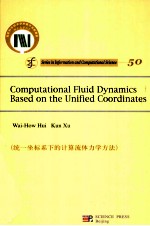
- 作 者:许为厚,徐昆著
- 出 版 社:北京:科学出版社
- 出版年份:2011
- ISBN:9787030323194
- 标注页数:190 页
- PDF页数:4 页
请阅读订购服务说明与试读!
订购服务说明
1、本站所有的书默认都是PDF格式,该格式图书只能阅读和打印,不能再次编辑。
2、除分上下册或者多册的情况下,一般PDF页数一定要大于标注页数才建议下单购买。【本资源4 ≥190页】
图书下载及付费说明
1、所有的电子图书为PDF格式,支持电脑、手机、平板等各类电子设备阅读;可以任意拷贝文件到不同的阅读设备里进行阅读。
2、电子图书在提交订单后一般半小时内处理完成,最晚48小时内处理完成。(非工作日购买会延迟)
3、所有的电子图书都是原书直接扫描方式制作而成。
Chapter 1 Introduction 1
1.1 CFD as Numerical Solution to Nonlinear Hyperbolic PDEs 1
1.2 Role of Coordinates in CFD 2
1.3 Outline of the Book 5
References 6
Chapter 2 Derivation of Conservation Law Equations 9
2.1 Fluid as a Continuum 9
2.2 Derivation of Conservation Law Equations in Fixed Coordinates 10
2.3 Conservation Law Equations in Moving Coordinates 14
2.4 Integral Equations versus Partial Differential Equations 14
2.5 The Entropy Condition for Inviscid Flow Computation 17
References 18
Chapter 3 Review of Eulerian Computation for 1-D Inviscid Flow 19
3.1 Flow Discontinuities and Rankine-Hugoniot Conditions 19
3.2 Classification of Flow Discontinuities 21
3.3 Riemann Problem and its Solution 26
3.4 Preliminary Considerations of Numerical Computation 34
3.5 Godunov Scheme 35
3.6 High Resolution Schemes and Limiters 38
3.7 Defects of Eulerian Computation 39
References 40
Chapter 4 1-D Flow Computation Using the Unified Coordinates 43
4.1 Gas Dynamics Equations Based on the Unified Coordinates 43
4.2 Shock-Adaptive Godunov Scheme 45
4.3 The Use of Entropy Conservation Law for Smooth Flow Computation 47
4.4 The Unified Computer Code 48
4.5 Cure of Defects of Eulerian and Lagrangian Computation by the UC Method 52
4.6 Conclusions 66
References 66
Chapter 5 Comments on Current Methods for Multi-Dimensional Flow Computation 69
5.1 Eulerian Computation 69
5.2 Lagrangian Computation 71
5.3 The ALE Computation 73
5.4 Moving Mesh Methods 73
5.5 Optimal Coordinates 74
References 75
Chapter 6 The Unified Coordinates Formulation of CFD 79
6.1 Hui Transformation 79
6.2 Geometric Conservation Laws 80
6.3 Derivation of Governing Equations in Conservation Form 80
References 85
Chapter 7 Properties of the Unified Coordinates 87
7.1 Relation to Eulerian Computation 87
7.2 Relation to Classical Lagrangian Coordinates 87
7.3 Relation to Arbitrary-Lagrangian-Eulerian Computation 88
7.4 Contact Resolution 89
7.5 Mesh Orthogonality 89
7.6 Unified Coordinates for Steady Flow 91
7.7 Effects of Mesh Movement on the Flow 92
7.8 Relation to Other Moving Mesh Methods 92
7.9 Relation to Mesh Generation and the Level-Set Function Method 94
References 94
Chapter 8 Lagrangian Gas Dynamics 97
8.1 Lagrangian Gas Dynamics Equations 97
8.2 Weak Hyperbolicity 98
8.3 Non-Equivalency of Lagrangian and Eularian Formulation 99
References 100
Chapter 9 Steady 2-D and 3-D Supersonic Flow 101
9.1 The Unified Coordinates for Steady Flow 101
9.2 Euler Equations in the Unified Coordinates 102
9.3 The Space-Marching Computation 104
9.4 Examples 105
9.5 3-D Flow 111
References 114
Chapter 10 Unsteady 2-D and 3-D Flow Computation 117
10.1 Summary of Solution to the 2-D Euler Equations Using the Unified Coordinates 117
10.2 Computation Procedure 119
10.3 Examples 122
References 125
Chapter 11 Viscous Flow Computation Using Navier-Stokes Equations 127
11.1 Navier-Stokes Equations in the Unified Coordinates 127
11.2 The Angle-preserving Equation 130
11.3 Advantages of the g-equation Over the h-equation 131
11.4 Boundary Condition and Movement of Boundary Cells 133
11.5 Solution Strategies 134
11.6 Test Examples:Shock/Boundary Flow Interaction and Shock/Shock Interaction 138
References 145
Chapter 12 Applications of the Unified Coordinates to Kinetic Theory 147
12.1 Brief Introduction of Gas-Kinetic Theory 147
12.2 Gas-Kinetic BGK Model Under the Unified Coordinate Transformation 152
12.3 Numerical BGK-NS Scheme in a Moving Mesh System 153
12.4 Numerical Procedure 157
12.5 Numerical Examples 158
12.6 Conclusion 168
References 168
Chapter 13 Summary 171
Appendix A Riemann Problem for 1-D Flow in the Unified Coordinate 173
Appendix B Computer Code for 1-D Flow in the Unified Coordinate 177
